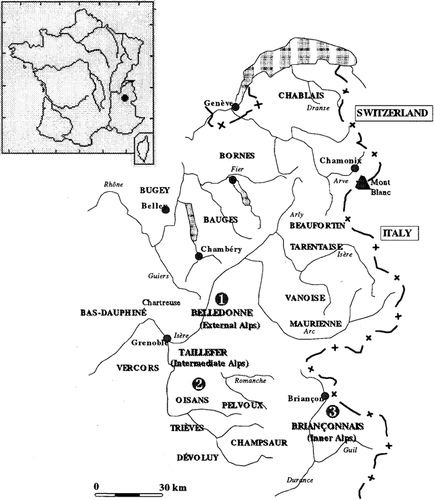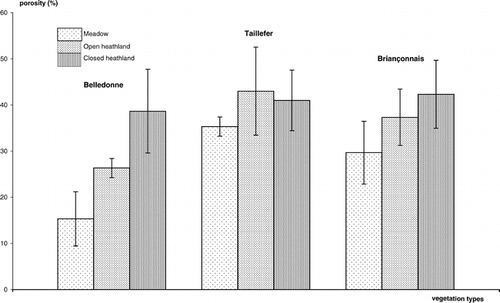Figures & data
FIGURE 1. The study sites in the northwestern Alps: (1) “Belledonne” (external Alps), (2) “Taillefer” (intermediate Alps), (3) “Briançonnais” (inner Alps)

FIGURE 2. Evolution of humus porosity in the three site with an increasing influence of shrubs (meadow to closed heathland)

TABLE 1 Ecological features of the three sites
TABLE 2 Structural and biological characteristics of each physiognomic stage in the three sites. M = meadow, O.H. = open heathland, C.H. = closed heathland
TABLE 3 The chemical parameters of humus and meadow soils in each physiognomic stage in the three sites. Mean values (± standard deviation) of 3 samples in humus (0–10 cm). M = meadow, O.H. = open heathland, C.H. = closed heathland
TABLE 4 The main soil types in each site (Baize and Girard, 1992; italics, C.P.C.S. classification, 1967)
TABLE 5 “Site” and “vegetation type” effects for 14 physical and chemical variables (ANOVA, Duncan grouping). Site (B = Belledonne, T = Taillefer, Br = Briançonnais) and type (M = meadow, O.H. = open heathland, C.H. = closed heathland). Shaded boxes have a significant effect
TABLE 6 Correlation number between “vegetation type” and “site” for 14 physical and chemical variables (Duncan grouping). M = meadow, O.H. = open heathland, C.H. = closed heathland
TABLE 7 The humus types under every physiognomic stage in the three sites (Duchaufour, 1997; italics, Baize and Girard, 1992)
TABLE 8 Micromorphologic characterization of 27 thin sections of humus using standardized methods (9 per site). In each column, the results (aggregate size, structure, aggregation degree, porosity, etc.) represent the analysis of 3 thin sections by humus (about 120–140 cm2) and by physiognomic stage. M = meadow, O.H. = open heathland, C.H. = closed heathland
TABLE 9 Evolution and comparison of microfauna in humus under each physiognomic stage in the three sites (3 × 300 cm3 are analyzed per stage). M = meadow, O.H. = open heathland, C.H. = closed heathland